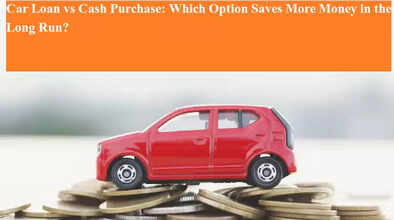Car Loan vs Cash Purchase: Which Option Saves More Money in the Long Run?

When it comes to buying a car, one of the most common dilemmas for buyers is whether to pay the entire amount upfront in cash or to finance the purchase through a car loan. At first glance, paying in cash may seem like the smarter move—after all, it eliminates the burden of EMIs and interest payments. However, financial experts argue that taking a loan strategically and investing the remaining funds can actually prove more profitable in the long run.
The Cash Payment Scenario
Suppose you have ₹20 lakh in hand and plan to buy a car worth ₹20 lakh. If you choose to pay the full amount in cash, you own the vehicle outright with no debt obligations. The advantage is clear—no EMIs, no interest, and no processing fees.
But there is a downside. By spending all your savings at once, your bank account is drained, leaving you with no liquidity for emergencies or investment opportunities. While this may give peace of mind in terms of debt-free ownership, financially, it may not be the most optimal choice.
Car Loan Option: A Case Study
Wealth manager Vijay Maheshwari recently shared an interesting calculation to highlight how taking a loan can be more beneficial. Let’s assume you make a down payment of ₹5 lakh and take a car loan of ₹15 lakh for a tenure of 5 years at an interest rate of 9%.
-
Loan amount: ₹15 lakh
-
Tenure: 5 years
-
Interest rate: 9%
-
Total interest paid: Approximately ₹3.6 lakh
At the end of 5 years, the total outflow on the loan is ₹18.6 lakh (principal + interest). Effectively, the car’s cost rises to about ₹23.6 lakh including the down payment.
What If You Invest the Remaining Cash?
Now consider the alternative. Instead of paying ₹20 lakh upfront, you invest the remaining ₹15 lakh (after making a ₹5 lakh down payment) into a safe or moderately risky mutual fund that offers an average annual return of 11%.
Over 5 years, this investment could grow to nearly ₹25.8 lakh, thanks to the power of compounding. Even after accounting for the ₹3.6 lakh paid as loan interest, the net gain stands at around ₹7.2 lakh.
This clearly shows that leveraging a car loan while simultaneously investing surplus funds can leave you with higher overall wealth compared to making a lump sum payment.
Why Loans + Investments Can Be Smarter
The logic behind this approach lies in opportunity cost and compounding returns:
-
With each EMI, the loan balance reduces, and so does the interest outgo over time.
-
On the other hand, invested funds continue to grow not just on the principal but also on accumulated returns.
-
This difference in growth versus repayment creates a wealth advantage, provided the investment consistently outperforms the loan interest rate.
Example of Bank Loan Rates
Some banks offer car loans at competitive rates. For instance, UCO Bank provides new car loans starting from 7.60% with EMIs ranging between ₹10,043 to ₹10,685. While the processing fee of 0.50% (around ₹5,000) may feel slightly higher, the lower interest rate can make borrowing cost-effective.
Key Takeaways for Buyers
-
Paying in cash ensures peace of mind but ties up your capital.
-
Taking a car loan and investing the remaining funds can generate higher returns.
-
The success of this strategy depends on disciplined investing and market performance.
-
Always compare interest rates, processing fees, and EMI affordability before making a decision.
Final Word
Choosing between cash purchase and a car loan is not just about convenience but about long-term financial planning. If you are confident about disciplined investing and can handle EMIs comfortably, opting for a loan while investing your surplus can lead to better wealth creation. However, if you prefer financial simplicity and debt-free ownership, paying in cash might suit you better.
Either way, the key lies in aligning your decision with your financial goals, risk appetite, and liquidity needs.

